What's inside
What's inside
 Key Ingredients
Key Ingredients

 Benefits
Benefits

 Concerns
Concerns

 Ingredients Side-by-side
Ingredients Side-by-side

Water
Skin ConditioningGlycerin
HumectantIsododecane
EmollientCyclopentasiloxane
EmollientDipropylene Glycol
HumectantNiacinamide
SmoothingSqualane
EmollientPolymethylsilsesquioxane
C14-22 Alcohols
Emulsion StabilisingHdi/Trimethylol Hexyllactone Crosspolymer
Ammonium Acryloyldimethyltaurate/Vp Copolymer
C30-45 Alkyl Cetearyl Dimethicone Crosspolymer
EmollientCarbomer
Emulsion StabilisingPentylene Glycol
Skin ConditioningTocopheryl Acetate
AntioxidantC12-20 Alkyl Glucoside
EmulsifyingSteareth-21
CleansingDisodium EDTA
Salicylic Acid
MaskingSodium Hydroxide
BufferingMannitol
HumectantXylitol
HumectantHexyldecanol
EmollientPEG/PPG-18/18 Dimethicone
EmulsifyingRhamnose
HumectantMalachite Extract
AntioxidantPyrus Malus Seed Extract
Skin ConditioningBrassica Campestris Sterols
EmollientTocopherol
AntioxidantParfum
MaskingWater, Glycerin, Isododecane, Cyclopentasiloxane, Dipropylene Glycol, Niacinamide, Squalane, Polymethylsilsesquioxane, C14-22 Alcohols, Hdi/Trimethylol Hexyllactone Crosspolymer, Ammonium Acryloyldimethyltaurate/Vp Copolymer, C30-45 Alkyl Cetearyl Dimethicone Crosspolymer, Carbomer, Pentylene Glycol, Tocopheryl Acetate, C12-20 Alkyl Glucoside, Steareth-21, Disodium EDTA, Salicylic Acid, Sodium Hydroxide, Mannitol, Xylitol, Hexyldecanol, PEG/PPG-18/18 Dimethicone, Rhamnose, Malachite Extract, Pyrus Malus Seed Extract, Brassica Campestris Sterols, Tocopherol, Parfum
Water
Skin ConditioningCaprylic/Capric Triglyceride
MaskingGlycerin
HumectantGlyceryl Behenate
EmollientVitis Vinifera Seed Oil
EmollientBehenyl Alcohol
EmollientLecithin
EmollientHouttuynia Cordata Extract
Skin ConditioningCeramide NP
Skin ConditioningPhaeodactylum Tricornutum Extract
HumectantUrea
BufferingYeast Amino Acids
HumectantTrehalose
HumectantInositol
HumectantTaurine
BufferingBetaine
HumectantLactobacillus Ferment
Skin ConditioningHelianthus Annuus Seed Oil
EmollientHydroxyacetophenone
AntioxidantTocopherol
AntioxidantEthylhexylglycerin
Skin ConditioningPropanediol
SolventSodium Acrylates Copolymer
Xanthan Gum
EmulsifyingCitric Acid
BufferingLeuconostoc/Radish Root Ferment Filtrate
AntimicrobialChlorphenesin
AntimicrobialDehydroacetic Acid
PreservativeSodium Benzoate
MaskingWater, Caprylic/Capric Triglyceride, Glycerin, Glyceryl Behenate, Vitis Vinifera Seed Oil, Behenyl Alcohol, Lecithin, Houttuynia Cordata Extract, Ceramide NP, Phaeodactylum Tricornutum Extract, Urea, Yeast Amino Acids, Trehalose, Inositol, Taurine, Betaine, Lactobacillus Ferment, Helianthus Annuus Seed Oil, Hydroxyacetophenone, Tocopherol, Ethylhexylglycerin, Propanediol, Sodium Acrylates Copolymer, Xanthan Gum, Citric Acid, Leuconostoc/Radish Root Ferment Filtrate, Chlorphenesin, Dehydroacetic Acid, Sodium Benzoate
 Reviews
Reviews

Ingredients Explained
These ingredients are found in both products.
Ingredients higher up in an ingredient list are typically present in a larger amount.
Glycerin is already naturally found in your skin. It helps moisturize and protect your skin.
A study from 2016 found glycerin to be more effective as a humectant than AHAs and hyaluronic acid.
As a humectant, it helps the skin stay hydrated by pulling moisture to your skin. The low molecular weight of glycerin allows it to pull moisture into the deeper layers of your skin.
Hydrated skin improves your skin barrier; Your skin barrier helps protect against irritants and bacteria.
Glycerin has also been found to have antimicrobial and antiviral properties. Due to these properties, glycerin is often used in wound and burn treatments.
In cosmetics, glycerin is usually derived from plants such as soybean or palm. However, it can also be sourced from animals, such as tallow or animal fat.
This ingredient is organic, colorless, odorless, and non-toxic.
Glycerin is the name for this ingredient in American English. British English uses Glycerol/Glycerine.
Learn more about GlycerinTocopherol (also known as Vitamin E) is a common antioxidant used to help protect the skin from free-radicals and strengthen the skin barrier. It's also fat soluble - this means our skin is great at absorbing it.
Vitamin E also helps keep your natural skin lipids healthy. Your lipid skin barrier naturally consists of lipids, ceramides, and fatty acids. Vitamin E offers extra protection for your skin’s lipid barrier, keeping your skin healthy and nourished.
Another benefit is a bit of UV protection. Vitamin E helps reduce the damage caused by UVB rays. (It should not replace your sunscreen). Combining it with Vitamin C can decrease sunburned cells and hyperpigmentation after UV exposure.
You might have noticed Vitamin E + C often paired together. This is because it is great at stabilizing Vitamin C. Using the two together helps increase the effectiveness of both ingredients.
There are often claims that Vitamin E can reduce/prevent scarring, but these claims haven't been confirmed by scientific research.
Learn more about TocopherolWater. It's the most common cosmetic ingredient of all. You'll usually see it at the top of ingredient lists, meaning that it makes up the largest part of the product.
So why is it so popular? Water most often acts as a solvent - this means that it helps dissolve other ingredients into the formulation.
You'll also recognize water as that liquid we all need to stay alive. If you see this, drink a glass of water. Stay hydrated!
Learn more about Water